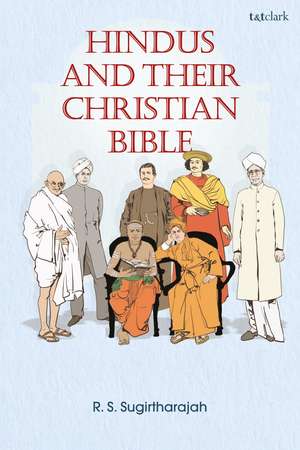Hindus and Their Christian Bible
Autor Professor R. S. Sugirtharajahen Limba Engleză Hardback – 21 feb 2024
Preț: 510.25 lei
Preț vechi: 731.12 lei
-30% Nou
Puncte Express: 765
Preț estimativ în valută:
97.64€ • 104.41$ • 81.41£
97.64€ • 104.41$ • 81.41£
Carte tipărită la comandă
Livrare economică 17 aprilie-01 mai
Preluare comenzi: 021 569.72.76
Specificații
ISBN-13: 9780567711533
ISBN-10: 0567711536
Pagini: 224
Dimensiuni: 156 x 234 mm
Greutate: 0.49 kg
Editura: Bloomsbury Publishing
Colecția T&T Clark
Locul publicării:London, United Kingdom
ISBN-10: 0567711536
Pagini: 224
Dimensiuni: 156 x 234 mm
Greutate: 0.49 kg
Editura: Bloomsbury Publishing
Colecția T&T Clark
Locul publicării:London, United Kingdom
Caracteristici
Examines Hindu interactions with the bible from within their own contexts rather than through the caricatures of contemporaneous colonial accounts
Notă biografică
R.S. Sugirtharajah is Professor Emeritus of Biblical Hermeneutics at the University of Birmingham, UK. He is the author of many books, including The Brahmin and His Bible (T&T Clark, 2019).
Cuprins
AcknowledgementsIntroduction 1 .A Moral Testament2. Textual Ordinances for Temple Worshippers3. Universal and Intuitive Truths 4. A Saiva Castiram5. A World-renouncing Gospel6. Bapu's Bible7. A Variant of the Vedas 8. Fanatical and FraudulentAfterword: Challenges and ConfrontationsIndex
Recenzii
Sugirtharajah has an enviable record of solid and substantial publications going back four decades and, to overuse a trite image, like good wine, ages really well! His sustained engagement regarding the "use" of the Bible, read thorough a meticulously informed postcolonial lens, has further consolidated his standing at the forefront of scholars who have deepened and enriched the field of postcolonial explorations and investigations. This volume fills a glaring gap in research, in that while there have been attempts to look at the person and work of Jesus from the point of view of Hindu interpreters, like, for example, Stanley J. Samartha's book, The Hindu Response to the Unbound Christ (Bangalore: CISRS, 1974), there have been very few attempts to look at the way Hindu commentators on Christianity used the Bible either polemically or to foster an understanding of scriptures, a task not helped by some of the indigenous translations using the word "Satyaveda" for the Bible, implying that that was the true Veda, at the cost of relegating the rich Hindu literary religious traditions, including the Vedas, to a subordinate status. Without glossing over the undoubted painful and hurtful legacy of the use of the Bible to trivialize the religious quest of a huge swathe of people in the Indian subcontinent and beyond, and without underplaying the attempts of prominent Hindus in the past and even today to come to terms with what the Bible says, Sugirtharajah in this outstanding book not only recognizes how the Bible was used to dominate cultures, societies, and peoples, but also how the Bible was "enrolled, enlisted and encroached upon" and how Hindu thinkers and practitioners resisted this domination in many different ways, leaving us with the ongoing question as to plurality and multiplicity when confronted with claims to the "unique" and "only". Sugirtharajah is to be commended for not just considering the "usual" names in presenting his analysis, in this case Roy, Sen, Gandhi, Vivekananda, and Radhakrishnan, but also by "recovering" the thinking of those whose contributions may have faded with time or have not received the attention that they deserved. In that sense the chapter on Navalar is brilliant and fascinating, with Sugirtharajah at his best in translating directly from the Tamil and teasing out insights that have been submerged by an attitude that valorizes writings in English and easily (or arrogantly) overlooks the huge body of "vernacular" literature. This does not take away from each of the other chapters, including the one on Ramanathan, where each interpreter, or group of interpreters, not only come to voice but are brought into interaction with the thinking of those whom they may or may not have encountered in actuality. This "overlapping-conversation" that crisscrosses the book, gives Sugirtharajah the possibility of presenting us with incisive, and, at times, trenchant, comments that do so much to make this such a valuable book. What strikes one is how thin the line is between those who struggled to make sense of the Bible as a sacred text embodying a variety and range of teachings, without overlooking its colonial and religious usage and misapplication, and those who are bent on "exposing" the Bible by highlighting what are seen as its negative parts and stressing how it was used to mock the faith traditions and practices of the peoples with whom it was brought into interaction. Is there the possibility that memories can be healed and that polemical and hurtful practices of fundamentalist Christian preachers and teachers today can be overcome, leading to some kind of considerate reconciliation and a combined shared quest for the dignity of all people?
